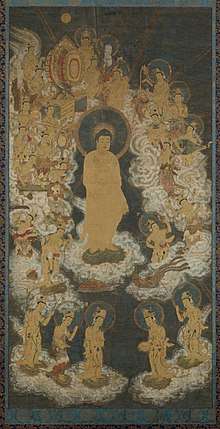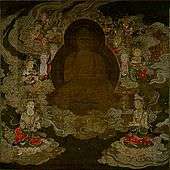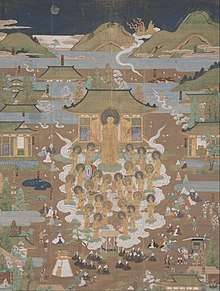Raigō
Raigō (来迎, "welcoming approach") in Japanese Buddhism is the appearance of the Amida Buddha on a "purple" cloud (紫雲) at the time of one's death.[1]

Depictions
The Amida would arrive either accompanied by two bodhisattva, making it a triad depiction, or with a large retinue that also includes musicians playing celestial music accompanying the Buddha. The Buddha would then lift the spirit of the deceased up and ascend back to the pure land. The belief of the Western Paradise for the souls is the most popular.
It has given rise to a type of Japanese paintings (raigō-zu). As a ritual, such a painting is carried into the house of a person who is near death.
Among the upper classes, raigō paintings and sculpture became very popular, as they depicted the Amida Buddha coming down in celebration in relation to dead relatives or to one's own house. Some of these paintings are clearly yamato-e, or Japanese paintings in that they gave artists a chance to paint Japanese landscapes.
 The Amida arriving at the person's home, hanging scroll painting, 13th century
The Amida arriving at the person's home, hanging scroll painting, 13th century Raigō painting from the late Heian period
Raigō painting from the late Heian period The Amida welcomes Chûjôhime to the Western Paradise, hanging scroll painting, 16th century
The Amida welcomes Chûjôhime to the Western Paradise, hanging scroll painting, 16th century
References
- "Raigō". HighBeam Research, Inc. Retrieved 16 January 2013.
External links
![]()